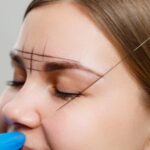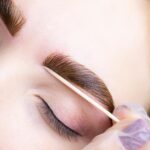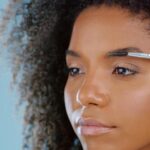If you experience a brow lamination reaction, seek immediate medical attention. Manage symptoms at home by keeping the area clean, avoiding makeup, and using cold compresses. Future prevention includes performing a patch test and considering alternatives to brow lamination.
Ever wondered what to do if you have a brow lamination reaction? This comprehensive guide offers you essential information and advice, from recognizing an allergic reaction to brow lamination, to understanding how to manage these reactions at home, and how to evaluate the risks of the procedure. We also discuss alternatives to brow lamination, should you choose to avoid this treatment in the future.
Recognizing an Allergic Reaction to Brow Lamination
When your brows have been laminated, it’s essential to monitor for any signs of an allergic reaction. Some common symptoms of an allergic reaction to brow lamination include redness, itching, swelling, pain, and in severe cases, blistering.
“It’s important to keep a close eye on your brows following the lamination process. If you notice any severe discomfort or abnormal symptoms, you might be having an allergic reaction.”
Table: Symptoms of an Allergic Reaction
| Symptom | Description |
|---|---|
| Redness | The skin around the brows might become red and inflamed. |
| Itching | There could be an uncomfortable itching sensation. |
| Swelling | The brows or surrounding area might noticeably swell. |
| Pain | A discomforting pain might be experienced. |
| Blistering | In severe cases, blisters could appear around the brows. |
Remember, everyone’s body reacts differently, and some might not exhibit all of these symptoms. If you experience a combination of these symptoms or they persist for more than 24 hours, it’s likely you’re dealing with a reaction to the brow lamination process.
Immediate Actions to Take in Case of a Brow Lamination Reaction
If you suspect you’re having an allergic reaction to brow lamination, there are immediate steps you can take to alleviate your symptoms and seek treatment. First, stop using any brow products, including those provided for aftercare. Clean the area gently with lukewarm water and pat dry.
If the reaction is mild, you might find relief with over-the-counter hydrocortisone creams or antihistamines. These can help reduce redness, itching, and swelling.
“If you’re experiencing an allergic reaction, refrain from touching or scratching your brows. This can exacerbate the symptoms and potentially lead to infection.”
It’s important to remember, these are temporary solutions, and you should seek medical attention as soon as possible.
Professional Medical Treatments for Brow Lamination Reactions
If your symptoms persist or worsen, it’s essential to seek professional medical help immediately. A dermatologist or allergist can help determine the best course of treatment based on the severity of your reaction.
They might prescribe a stronger steroid cream to reduce inflammation or an antibiotic if an infection has developed. In severe cases, you might be referred to an ophthalmologist if your eyes have been affected by the reaction.
“Seeking professional medical help promptly is crucial in managing a severe allergic reaction and preventing any complications.”
Note that these treatments aim to alleviate symptoms but don’t address the root cause. If you’ve had an allergic reaction to brow lamination, it’s likely you’re allergic to one or more of the ingredients used in the procedure, and future lamination treatments should be avoided.
Home Care Strategies for Managing Brow Lamination Reactions
Once you’ve received professional medical advice, managing a brow lamination reaction at home can be essential to your recovery. It’s important to keep the area clean and avoid any further irritation.
Wash your face regularly with a gentle cleanser, and avoid using any makeup or skincare products on the affected area until your symptoms have completely resolved. Cold compresses can help reduce swelling and relieve discomfort.
“To soothe the discomfort, apply a cold compress to the affected area. It can help reduce inflammation and alleviate the itchiness.”
Table: Home Care Strategies for Brow Lamination Reactions
| Strategy | Description |
|---|---|
| Keep the Area Clean | Use a gentle cleanser to wash your face, avoiding harsh soaps or scrubs. |
| Avoid Makeup and Skincare Products | Don’t use any products on the affected area until symptoms have resolved. |
| Use Cold Compresses | Apply a cold compress to help reduce swelling and relieve discomfort. |
It’s crucial to follow any advice or treatment plan provided by your doctor, including the use of prescribed creams or medications. If your symptoms do not improve or worsen despite these strategies, seek medical attention immediately.
Preventing Future Reactions: Evaluating Brow Lamination Risks
If you’ve had an allergic reaction to brow lamination, it’s essential to evaluate the risks of undergoing the procedure again in the future. In most cases, if you’ve reacted once, you’re likely to react again, and it’s generally recommended to avoid further brow lamination treatments.
“If you’ve experienced a reaction to brow lamination, it’s recommended to avoid the treatment in the future.”
Alternative brow treatments, such as microblading or brow tinting, might also carry similar risks if they use the same or similar ingredients. Before considering any future brow treatments, discuss your previous allergic reaction with the professional performing the procedure.
Lessons Learned: Alternatives to Brow Lamination After a Reaction
After experiencing a reaction to brow lamination, you might be wondering about alternatives. Thankfully, there are many other ways to achieve full, groomed brows without lamination.
Options like brow tinting, microblading, or even simple grooming and filling in with brow products can create a similar effect. Always ensure to do a patch test when trying a new product or procedure to prevent another allergic reaction.
“There are plenty of brow lamination alternatives that can help you achieve the look you desire, from brow tinting to microblading.”
It’s essential to discuss any previous reactions with the professional performing the procedure and ensure they understand your history before proceeding with a new treatment. If a patch test is an option, always choose to do it – it can help prevent another unpleasant allergic reaction.
The Importance of Patch Tests in Avoiding Brow Lamination Reactions
A patch test is a preventive measure and can help predict if you are likely to have a reaction to the brow lamination treatment. It involves applying a small amount of the lamination product on your skin, often behind the ear or the inner elbow, and waiting for 48 hours to see if a reaction occurs.
“A patch test can help identify potential allergic reactions to brow lamination products before the treatment.”
Table: Importance of Patch Tests in Avoiding Brow Lamination Reactions
| Consideration | Details |
|---|---|
| Purpose of a Patch Test | It’s used to identify any potential allergic reactions to the product. |
| Procedure | A small amount of the lamination product is applied on the skin (usually behind the ear or inner elbow). |
| Observation Period | It takes 48 hours to see if a reaction occurs. |
If you experience any redness, itchiness, swelling, or discomfort at the site of the patch test, this suggests that you might have an allergy to one or more of the ingredients in the product. In this case, you should avoid having the procedure done.
Not all reactions to brow lamination are allergic. Irritation or damage can occur from improper technique, even if you aren’t allergic to the product. That’s why it’s essential to ensure that the procedure is performed by a trained, experienced professional.
Key Takeaways
- Brow lamination reactions can range from mild to severe and require immediate action.
- After a reaction, careful management at home is crucial in addition to professional treatment.
- Avoiding brow lamination in the future is typically recommended if you’ve had a reaction.
- Alternatives to brow lamination are available and should be considered after a reaction.
- Patch tests are essential in predicting and preventing possible reactions.
Conclusion
Having a reaction to brow lamination can be a stressful and uncomfortable experience. However, with the right knowledge and guidance, managing such a situation becomes a lot more manageable. This guide provides valuable insights on how to handle a brow lamination reaction and offers advice for anyone considering this procedure.







